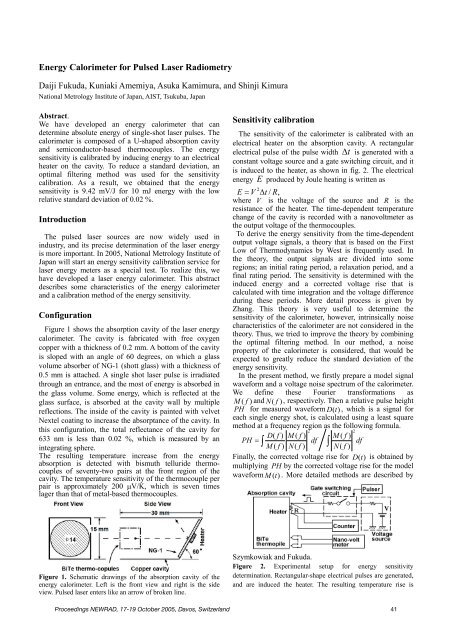Here - PMOD/WRC
Here - PMOD/WRC
Here - PMOD/WRC
You also want an ePaper? Increase the reach of your titles
YUMPU automatically turns print PDFs into web optimized ePapers that Google loves.
Energy Calorimeter for Pulsed Laser Radiometry<br />
Daiji Fukuda, Kuniaki Amemiya, Asuka Kamimura, and Shinji Kimura<br />
National Metrology Institute of Japan, AIST, Tsukuba, Japan<br />
Abstract.<br />
We have developed an energy calorimeter that can<br />
determine absolute energy of single-shot laser pulses. The<br />
calorimeter is composed of a U-shaped absorption cavity<br />
and semiconductor-based thermocouples. The energy<br />
sensitivity is calibrated by inducing energy to an electrical<br />
heater on the cavity. To reduce a standard deviation, an<br />
optimal filtering method was used for the sensitivity<br />
calibration. As a result, we obtained that the energy<br />
sensitivity is 9.42 mV/J for 10 mJ energy with the low<br />
relative standard deviation of 0.02 %.<br />
Introduction<br />
The pulsed laser sources are now widely used in<br />
industry, and its precise determination of the laser energy<br />
is more important. In 2005, National Metrology Institute of<br />
Japan will start an energy sensitivity calibration service for<br />
laser energy meters as a special test. To realize this, we<br />
have developed a laser energy calorimeter. This abstract<br />
describes some characteristics of the energy calorimeter<br />
and a calibration method of the energy sensitivity.<br />
Configuration<br />
Figure 1 shows the absorption cavity of the laser energy<br />
calorimeter. The cavity is fabricated with free oxygen<br />
copper with a thickness of 0.2 mm. A bottom of the cavity<br />
is sloped with an angle of 60 degrees, on which a glass<br />
volume absorber of NG-1 (shott glass) with a thickness of<br />
0.5 mm is attached. A single shot laser pulse is irradiated<br />
through an entrance, and the most of energy is absorbed in<br />
the glass volume. Some energy, which is reflected at the<br />
glass surface, is absorbed at the cavity wall by multiple<br />
reflections. The inside of the cavity is painted with velvet<br />
Nextel coating to increase the absorptance of the cavity. In<br />
this configuration, the total reflectance of the cavity for<br />
633 nm is less than 0.02 %, which is measured by an<br />
integrating sphere.<br />
The resulting temperature increase from the energy<br />
absorption is detected with bismuth telluride thermocouples<br />
of seventy-two pairs at the front region of the<br />
cavity. The temperature sensitivity of the thermocouple per<br />
pair is approximately 200 µV/K, which is seven times<br />
lager than that of metal-based thermocouples.<br />
Sensitivity calibration<br />
The sensitivity of the calorimeter is calibrated with an<br />
electrical heater on the absorption cavity. A rectangular<br />
electrical pulse of the pulse width ∆ t is generated with a<br />
constant voltage source and a gate switching circuit, and it<br />
is induced to the heater, as shown in fig. 2. The electrical<br />
energy E produced by Joule heating is written as<br />
2<br />
E = V ∆t<br />
/ R,<br />
where V is the voltage of the source and R is the<br />
resistance of the heater. The time-dependent temperature<br />
change of the cavity is recorded with a nanovoltmeter as<br />
the output voltage of the thermocouples.<br />
To derive the energy sensitivity from the time-dependent<br />
output voltage signals, a theory that is based on the First<br />
Low of Thermodynamics by West is frequently used. In<br />
the theory, the output signals are divided into some<br />
regions; an initial rating period, a relaxation period, and a<br />
final rating period. The sensitivity is determined with the<br />
induced energy and a corrected voltage rise that is<br />
calculated with time integration and the voltage difference<br />
during these periods. More detail process is given by<br />
Zhang. This theory is very useful to determine the<br />
sensitivity of the calorimeter, however, intrinsically noise<br />
characteristics of the calorimeter are not considered in the<br />
theory. Thus, we tried to improve the theory by combining<br />
the optimal filtering method. In our method, a noise<br />
property of the calorimeter is considered, that would be<br />
expected to greatly reduce the standard deviation of the<br />
energy sensitivity.<br />
In the present method, we firstly prepare a model signal<br />
waveform and a voltage noise spectrum of the calorimeter.<br />
We define these Fourier transformations as<br />
M ( f ) and N ( f ), respectively. Then a relative pulse height<br />
PH for measured waveform D (t)<br />
, which is a signal for<br />
each single energy shot, is calculated using a least square<br />
method at a frequency region as the following formula.<br />
2<br />
2<br />
= D(<br />
f ) M ( f ) M ( f )<br />
PH ∫<br />
df<br />
M ( f ) N(<br />
f )<br />
∫<br />
N(<br />
f )<br />
df<br />
Finally, the corrected voltage rise for D (t)<br />
is obtained by<br />
multiplying PH by the corrected voltage rise for the model<br />
waveform M (t)<br />
. More detailed methods are described by<br />
Figure 1. Schematic drawings of the absorption cavity of the<br />
energy calorimeter. Left is the front view and right is the side<br />
view. Pulsed laser enters like an arrow of broken line.<br />
Szymkowiak and Fukuda.<br />
Figure 2. Experimental setup for energy sensitivity<br />
determination. Rectangular-shape electrical pulses are generated,<br />
and are induced the heater. The resulting temperature rise is<br />
Proceedings NEWRAD, 17-19 October 2005, Davos, Switzerland 41
















